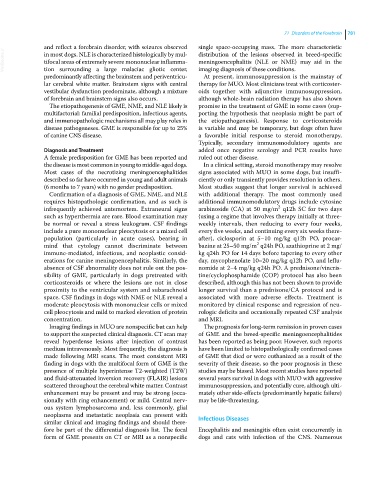Page 813 - Clinical Small Animal Internal Medicine
P. 813
71 Disorders of the Forebrain 781
and reflect a forebrain disorder, with seizures observed single space‐occupying mass. The more characteristic
VetBooks.ir in most dogs. NLE is characterized histologically by mul- distribution of the lesions observed in breed‐specific
meningoencephalitis (NLE or NME) may aid in the
tifocal areas of extremely severe mononuclear inflamma-
tion surrounding a large malaciac gliotic center,
At present, immunosuppression is the mainstay of
predominantly affecting the brainstem and periventricu- imaging diagnosis of these conditions.
lar cerebral white matter. Brainstem signs with central therapy for MUO. Most clinicians treat with corticoster-
vestibular dysfunction predominate, although a mixture oids together with adjunctive immunosuppression,
of forebrain and brainstem signs also occurs. although whole‐brain radiation therapy has also shown
The etiopathogenesis of GME, NME, and NLE likely is promise in the treatment of GME in some cases (sup-
multifactorial: familial predisposition, infectious agents, porting the hypothesis that neoplasia might be part of
and immunopathologic mechanisms all may play roles in the etiopathogenesis). Response to corticosteroids
disease pathogeneses. GME is responsible for up to 25% is variable and may be temporary, but dogs often have
of canine CNS disease. a favorable initial response to steroid monotherapy.
Typically, secondary immunomodulatory agents are
Diagnosis and Treatment added once negative serology and PCR results have
A female predisposition for GME has been reported and ruled out other disease.
the disease is most common in young to middle‐aged dogs. In a clinical setting, steroid monotherapy may resolve
Most cases of the necrotizing meningoencephalitides signs associated with MUO in some dogs, but insuffi-
described so far have occurred in young and adult animals ciently or only transiently provides resolution in others.
(6 months to 7 years) with no gender predisposition. Most studies suggest that longer survival is achieved
Confirmation of a diagnosis of GME, NME, and NLE with additional therapy. The most commonly used
requires histopathologic confirmation, and as such is additional immunomodulatory drugs include cytosine
2
infrequently achieved antemortem. Extraneural signs arabinoside (CA) at 50 mg/m q12h SC for two days
such as hyperthermia are rare. Blood examination may (using a regime that involves therapy initially at three‐
be normal or reveal a stress leukogram. CSF findings weekly intervals, then reducing to every four weeks,
include a pure mononuclear pleocytosis or a mixed cell every five weeks, and continuing every six weeks there-
population (particularly in acute cases), bearing in after), ciclosporin at 5–10 mg/kg q12h PO, procar-
2
mind that cytology cannot discriminate between bazine at 25–50 mg/m q24h PO, azathioprine at 2 mg/
immune‐mediated, infectious, and neoplastic consid- kg q24h PO for 14 days before tapering to every other
erations for canine meningoencephalitis. Similarly, the day, mycophenolate 10–20 mg/kg q12h PO, and leflu-
absence of CSF abnormality does not rule out the pos- nomide at 2–4 mg/kg q24h PO. A prednisone/vincris-
sibility of GME, particularly in dogs pretreated with tine/cyclophosphamide (COP) protocol has also been
corticosteroids or where the lesions are not in close described, although this has not been shown to provide
proximity to the ventricular system and subarachnoid longer survival than a prednisone/CA protocol and is
space. CSF findings in dogs with NME or NLE reveal a associated with more adverse effects. Treatment is
moderate pleocytosis with mononuclear cells or mixed monitored by clinical response and regression of neu-
cell pleocytosis and mild to marked elevation of protein rologic deficits and occasionally repeated CSF analysis
concentration. and MRI.
Imaging findings in MUO are nonspecific but can help The prognosis for long‐term remission in proven cases
to support the suspected clinical diagnosis. CT scan may of GME and the breed‐specific meningoencephalitides
reveal hyperdense lesions after injection of contrast has been reported as being poor. However, such reports
medium intravenously. Most frequently, the diagnosis is have been limited to histopathologically confirmed cases
made following MRI scans. The most consistent MRI of GME that died or were euthanized as a result of the
finding in dogs with the multifocal form of GME is the severity of their disease, so the poor prognosis in these
presence of multiple hyperintense T2‐weighted (T2W) studies may be biased. Most recent studies have reported
and fluid‐attenuated inversion recovery (FLAIR) lesions several years survival in dogs with MUO with aggressive
scattered throughout the cerebral white matter. Contrast immunosuppression, and potentially cure, although ulti-
enhancement may be present and may be strong (occa- mately other side‐effects (predominantly hepatic failure)
sionally with ring enhancement) or mild. Central nerv- may be life‐threatening.
ous system lymphosarcoma and, less commonly, glial
neoplasms and metastatic neoplasia can present with Infectious Diseases
similar clinical and imaging findings and should there-
fore be part of the differential diagnosis list. The focal Encephalitis and meningitis often exist concurrently in
form of GME presents on CT or MRI as a nonspecific dogs and cats with infection of the CNS. Numerous

